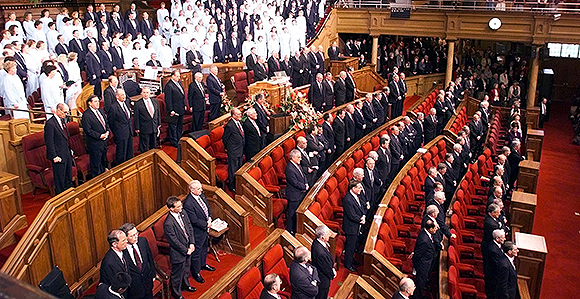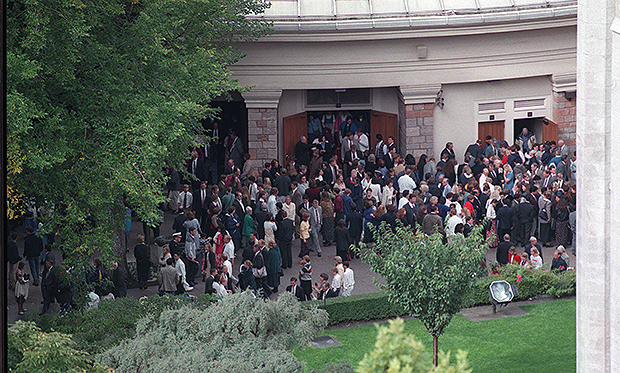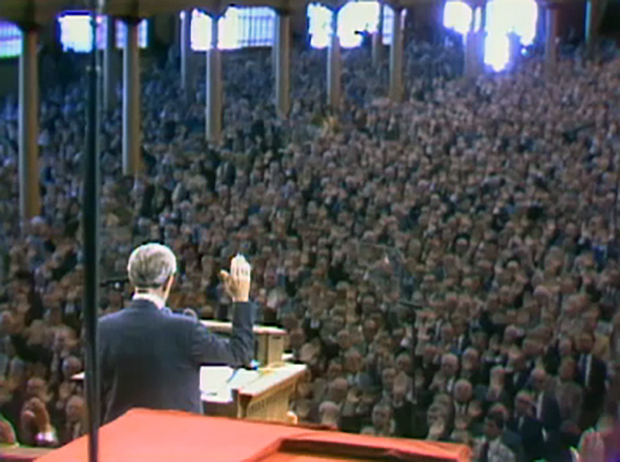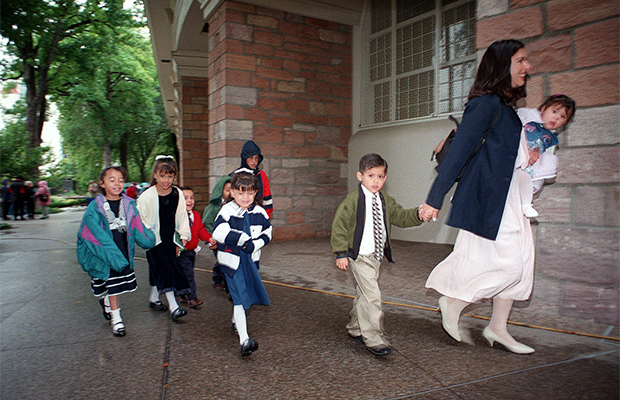Looking Back: Memories of 90—and Counting—General Conferences
Contributed By Gerry Avant, Church News senior contributing editor

The congregation stands to sing during the Sunday afternoon session of general conference on April 4, 1998.
Article Highlights
- After experiencing 90 general conferences, Church News reporter Gerry Avant recalls some spiritual highlights.
Related Links
This April’s general conference is the 91st for me since I began my journalism career 45 years ago.
Recently, someone asked me about some of my conference memories. Several came to mind. Here are some highlights.
Solemn assemblies
I was working as a city desk reporter at the Deseret News when President Harold B. Lee was sustained as the 11th President of the Church on October 6, 1972.
The first solemn assembly I attended as a Church News reporter was on April 6, 1974, during the Saturday morning session of the 144th Annual General Conference of the Church, when President Spencer W. Kimball was sustained as the 12th President of the Church. President N. Eldon Tanner and President Marion G. Romney were sustained as First and Second Counselors, respectively, in the First Presidency.
During that solemn assembly, President Kimball spoke on prophets and the history and meaning of solemn assemblies. In part, he said: “Solemn assemblies have been known among the Saints since the days of Israel. They have been of various kinds, but generally have been associated with the dedication of a temple or a special meeting appointed for the sustaining of a new First Presidency, or a meeting for the priesthood to sustain a revelation, such as the tithing revelation to President Lorenzo Snow.”
Membership approves revelation
The revelation extending priesthood and temple blessings to all worthy male members of the Church was accepted during the Saturday afternoon session of the 148th Semiannual General Conference of the Church, held on September 30, 1978.
The revelation appears as Official Declaration 2 and is placed among modern-day scripture at the end of the Doctrine and Covenants.
Participating in that conference session is one of the many times I felt I was a part of Church history in the making.
Nine new temples announced
On April 1, 1981, President Spencer W. Kimball announced that nine new temples would be built in various parts of the world: Chicago, Illinois; Dallas, Texas; Guatemala City, Guatemala; Lima, Peru; Frankfurt, Germany; Stockholm, Sweden; Seoul, South Korea; Manila, Philippines; and Johannesburg, South Africa. Up to then, it was the largest number of temples ever proposed at one time and the most international in setting, bringing the total number of temples scheduled or in operation to 37.
The initial announcement was made to 250 priesthood leaders, including regional representatives, stake presidents, General Authority executive administrators, and others gathered in a meeting on Wednesday before the weekend of the 151st Annual General Conference of the Church, April 4 and 5.
I interviewed several leaders and members from some of the newly announced temple districts. I remember in particular Lee Bum Tae, who was a stake patriarch in South Korea. Tears streamed down his face as he told me of his feelings upon hearing that a temple would be built in his home country. He said he always had been impressed to promise members the blessings of the temple. “I knew that a temple in Korea couldn’t be too far away because the Spirit has prompted me to name this specific blessing,” he said.
“I arrived in Salt Lake City two days after the announcement about the temples. I went to Temple Square at night. I looked up at angel Moroni’s trumpet and realized that the sounds of it will now reach my country, from the Paekdoo Mountains in the north to Cheju Island in the south. And because of this my country, which we love, will be blessed.”
Worldwide coverage of conference
I grew up in the Hazlehurst Branch of the Church in the Savannah Georgia District. In the early 1960s, WSAV-TV in Savannah aired only one televised session of conference. Television reception at my house, 100 miles from Savannah, was very poor. I remember sitting in front of the set, trying to see the black and white image of President David O. McKay and listening closely in an effort to hear what he was saying. I saw a lot of “snow” but little of the conference scene. I heard more static than speech.
With that background, I empathized with a member who called the Church News office from New Zealand during every conference weekend until 1978, when the Church expanded its satellite broadcasts of conference proceedings to many parts of the world, including New Zealand.
The member in New Zealand called us to find out who spoke, the topics of the talks, and announcements that might have been made. He said he shared the information with other members in New Zealand. They passed information along until many others in the island nation had the latest news of conference proceedings. Today, conference is carried across the globe through satellite broadcasts and live-stream internet transmissions and is translated into more than 90 languages.

Crowds exit the Salt Lake Tabernacle after the first session of general conference Saturday morning. Photo by Scott G Winterton, Deseret News.

Elder N. Eldon Tanner takes a sustaining vote after reading a letter by the First Presidency pertaining to the revelation on the priesthood in 1978.

Edith Maynez leads six of her own children and two nephews around the Tabernacle during the Saturday morning session of general conference on October 3, 1998. Photo by Scott G Winterton, Deseret News.
